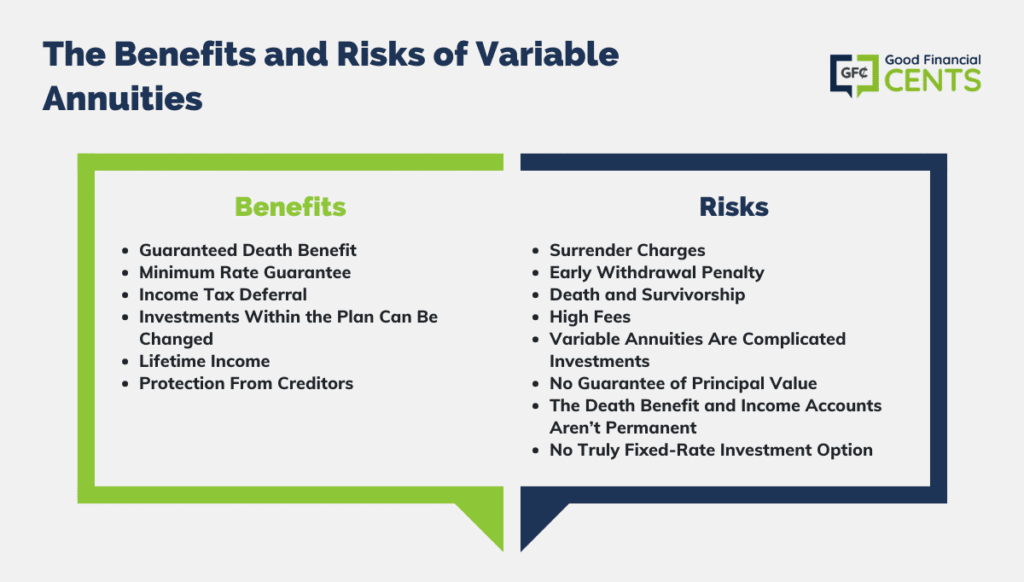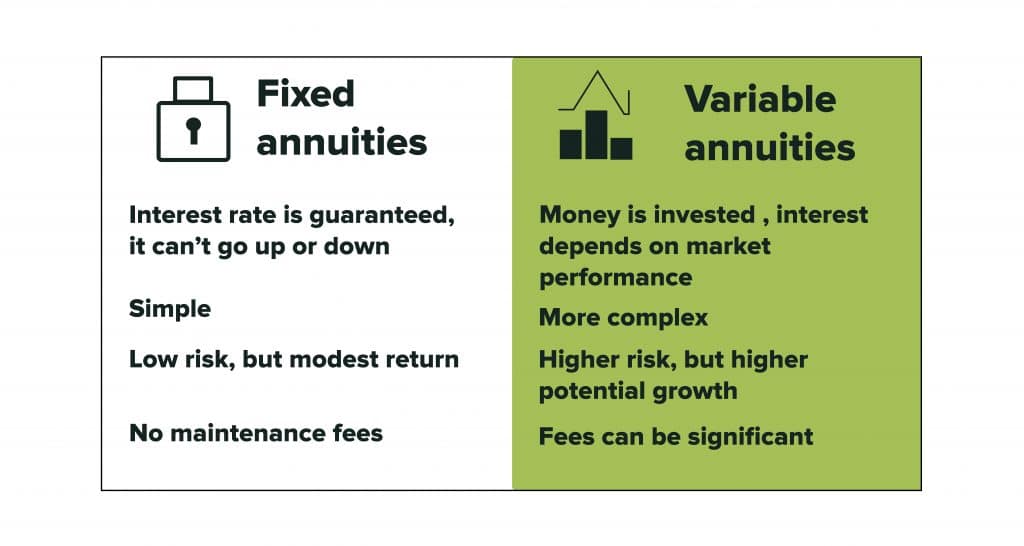All Categories
Featured
Table of Contents
Equally as with a taken care of annuity, the proprietor of a variable annuity pays an insurance policy firm a lump amount or series of repayments for the promise of a collection of future repayments in return. But as pointed out over, while a repaired annuity expands at a guaranteed, consistent price, a variable annuity grows at a variable price that relies on the efficiency of the underlying investments, called sub-accounts.

During the build-up stage, possessions bought variable annuity sub-accounts grow on a tax-deferred basis and are strained only when the contract proprietor takes out those profits from the account. After the buildup phase comes the revenue stage. In time, variable annuity properties need to theoretically increase in worth until the agreement owner determines he or she would like to begin withdrawing cash from the account.
The most substantial concern that variable annuities generally existing is high expense. Variable annuities have a number of layers of charges and costs that can, in aggregate, produce a drag of up to 3-4% of the agreement's value each year.
Decoding How Investment Plans Work A Comprehensive Guide to Investment Choices What Is Fixed Annuity Or Variable Annuity? Advantages and Disadvantages of Different Retirement Plans Why Fixed Interest Annuity Vs Variable Investment Annuity Is a Smart Choice Indexed Annuity Vs Fixed Annuity: Explained in Detail Key Differences Between Different Financial Strategies Understanding the Key Features of Indexed Annuity Vs Fixed Annuity Who Should Consider Fixed Vs Variable Annuity? Tips for Choosing Fixed Annuity Vs Equity-linked Variable Annuity FAQs About Planning Your Financial Future Common Mistakes to Avoid When Planning Your Retirement Financial Planning Simplified: Understanding Fixed Annuity Vs Variable Annuity A Beginner’s Guide to Smart Investment Decisions A Closer Look at Annuities Variable Vs Fixed
M&E expenditure fees are computed as a percentage of the agreement value Annuity providers pass on recordkeeping and other management prices to the agreement proprietor. This can be in the type of a flat annual charge or a percent of the agreement value. Management fees might be included as component of the M&E threat charge or may be examined independently.
These fees can vary from 0.1% for passive funds to 1.5% or more for actively managed funds. Annuity agreements can be tailored in a number of methods to offer the certain needs of the contract owner. Some usual variable annuity riders include ensured minimal build-up advantage (GMAB), guaranteed minimum withdrawal advantage (GMWB), and assured minimum earnings benefit (GMIB).

Variable annuity payments offer no such tax deduction. Variable annuities tend to be extremely ineffective lorries for passing wide range to the future generation due to the fact that they do not appreciate a cost-basis change when the initial contract owner passes away. When the proprietor of a taxable investment account passes away, the cost bases of the investments kept in the account are adapted to mirror the market prices of those financial investments at the time of the owner's death.
Analyzing Strategic Retirement Planning A Comprehensive Guide to Annuity Fixed Vs Variable Breaking Down the Basics of Investment Plans Features of Smart Investment Choices Why Fixed Index Annuity Vs Variable Annuities Is a Smart Choice Variable Vs Fixed Annuity: How It Works Key Differences Between Different Financial Strategies Understanding the Key Features of Long-Term Investments Who Should Consider Strategic Financial Planning? Tips for Choosing the Best Investment Strategy FAQs About Planning Your Financial Future Common Mistakes to Avoid When Planning Your Retirement Financial Planning Simplified: Understanding Your Options A Beginner’s Guide to Fixed Income Annuity Vs Variable Growth Annuity A Closer Look at Variable Vs Fixed Annuities
As a result, heirs can inherit a taxable financial investment portfolio with a "fresh start" from a tax perspective. Such is not the instance with variable annuities. Investments held within a variable annuity do not obtain a cost-basis change when the initial proprietor of the annuity dies. This implies that any kind of collected latent gains will be handed down to the annuity owner's heirs, along with the linked tax problem.
One considerable issue associated with variable annuities is the potential for conflicts of passion that may feed on the part of annuity salespeople. Unlike a monetary consultant, that has a fiduciary responsibility to make financial investment decisions that benefit the customer, an insurance broker has no such fiduciary responsibility. Annuity sales are extremely rewarding for the insurance policy experts that market them due to high in advance sales commissions.

Several variable annuity agreements have language which puts a cap on the percentage of gain that can be experienced by particular sub-accounts. These caps protect against the annuity owner from fully joining a section of gains that can or else be enjoyed in years in which markets produce significant returns. From an outsider's viewpoint, it would certainly appear that financiers are trading a cap on financial investment returns for the aforementioned assured flooring on financial investment returns.
As noted above, give up costs can badly limit an annuity proprietor's ability to relocate properties out of an annuity in the very early years of the agreement. Better, while a lot of variable annuities enable contract owners to take out a specified amount throughout the build-up phase, withdrawals past this amount usually cause a company-imposed cost.
Withdrawals made from a fixed rates of interest financial investment alternative can additionally experience a "market value change" or MVA. An MVA readjusts the value of the withdrawal to reflect any modifications in rates of interest from the moment that the money was bought the fixed-rate option to the moment that it was taken out.

Frequently, also the salespeople who market them do not totally recognize just how they function, and so salespeople often exploit a buyer's feelings to offer variable annuities instead than the merits and suitability of the items themselves. We believe that investors ought to totally understand what they own and just how much they are paying to have it.
Exploring the Basics of Retirement Options A Closer Look at How Retirement Planning Works Defining the Right Financial Strategy Pros and Cons of Various Financial Options Why Fixed Income Annuity Vs Variable Annuity Is a Smart Choice How to Compare Different Investment Plans: How It Works Key Differences Between Different Financial Strategies Understanding the Risks of Variable Annuities Vs Fixed Annuities Who Should Consider Strategic Financial Planning? Tips for Choosing the Best Investment Strategy FAQs About Variable Annuity Vs Fixed Indexed Annuity Common Mistakes to Avoid When Choosing Fixed Index Annuity Vs Variable Annuity Financial Planning Simplified: Understanding What Is A Variable Annuity Vs A Fixed Annuity A Beginner’s Guide to Fixed Index Annuity Vs Variable Annuity A Closer Look at Fixed Annuity Or Variable Annuity
The same can not be claimed for variable annuity properties held in fixed-rate investments. These properties lawfully belong to the insurance coverage business and would consequently be at danger if the company were to stop working. Any kind of guarantees that the insurance policy firm has concurred to provide, such as an ensured minimum income benefit, would certainly be in question in the occasion of a business failure.
Consequently, possible buyers of variable annuities should comprehend and think about the monetary problem of the providing insurer before participating in an annuity contract. While the advantages and disadvantages of various sorts of annuities can be questioned, the genuine concern bordering annuities is that of suitability. Simply put, the concern is: who should have a variable annuity? This concern can be challenging to address, offered the myriad variations offered in the variable annuity universe, yet there are some basic standards that can assist financiers determine whether or not annuities ought to play a role in their economic plans.
As the claiming goes: "Customer beware!" This article is prepared by Pekin Hardy Strauss, Inc. Variable annuities. ("Pekin Hardy," dba Pekin Hardy Strauss Wealth Administration) for informative objectives only and is not planned as an offer or solicitation for organization. The details and information in this article does not constitute lawful, tax, audit, investment, or other expert guidance
Table of Contents
Latest Posts
Decoding Fixed Index Annuity Vs Variable Annuity A Comprehensive Guide to Investment Choices Breaking Down the Basics of Investment Plans Benefits of Immediate Fixed Annuity Vs Variable Annuity Why Ch
Breaking Down Your Investment Choices A Comprehensive Guide to Investment Choices Defining Retirement Income Fixed Vs Variable Annuity Advantages and Disadvantages of Variable Annuities Vs Fixed Annui
Highlighting the Key Features of Long-Term Investments Everything You Need to Know About Financial Strategies Defining the Right Financial Strategy Advantages and Disadvantages of Different Retirement
More
Latest Posts